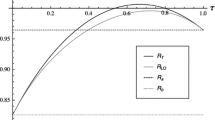Abstract
For many biological systems, the behavior of interest is contained in the evolution of transients rather than in the stability of equilibria. These include systems in which perturbations and interruptions occur on a time scale much shorter than the equilibration time, and those in which any final equilibrium is sensitive to initial conditions. In this article, we examine a model of fungal root disease in a crop involving primary and secondary infection mechanisms. This system is subject to regular interruptions in the form of harvesting and sowing. Using an asymptotic approach in which certain parameter values are assumed to be small, the model can be broken down into a set of simpler subsystems respresenting recognizable biological mechanisms. These linear models can be solved to give closed-form analytical solutions for transient evolution. From this information, it is possible to construct an annual map of disease severity in the crop, and determine the parameter values under which the infection will bulk up or fade out.
Similar content being viewed by others
References
Asher, M. 1993. Rhizomania. InThe Sugar Beet Crop: Science into Practice, D. Cooke and R. Scott (Eds.). London: Chapman and Hall, pp. 313–346.
Asher, M. J. C. and S. J. Blunt. 1987. The ecological requirements ofPolymyxa beta. InProceedings of the 50th International Institute of Sugarbeet Research Winter Congress, Brussels, pp. 45–55.
Blunt, S. J. 1989. The ecology ofPolymyxa betae, a fungal root parasite ofBeta vulgaris. Ph.D. thesis, University of Cambridge, U.K.
Gilligan, C. A. 1994. Temporal aspects of the development of root disease epidemics. InEpidemiology and Management of Root Diseases C. L. Cambpell and D. M. Benson (Eds.). New York: Springer-Verlag, pp. 149–193.
Gilligan, C. A. and A. Kleczkowski. 1997. Population dynamics of botanical epidemics involving primary and secondary infection.Phil. Trans. R. Soc. Lond. B 352, 591–608.
Holmes, M. H. 1995.Introduction to Perturbation Methods, Vol. 20 inTexts in Applied Mathematics. New York: Springer-Verlag.
Jeger, M. J. 1987. The influence of root growth and inoculum density on the dynamics of root disease epidemics: theoretical analysis.New Phytol.,107, 459–478.
Kleczkowski, A., D. J. Bailey and C. A. Gilligan. 1996. Dynamically generated variability in a plant pathogen system with biological control.Proc. R. Soc. Lond. B 263, 777–783.
Liu, W., H. Hethcote and S. Levin. 1987. Dynamical behaviour of epidemiological models with nonlinear incidence rates.J. Math. Biol. 25, 359–380.
Truscott, J. E. 1995. Environment forcing of simple plankton models.J. Plankton Res. 17, 2207–2232.
Tuitert, G. and G. J. Bollen. 1993. Recovery of resting spores ofPolymyxa betae from soil and the influence of duration of the bioassay on the detection level of beet necrotic yellow vein virus in soil.Neth. J. Plant. Pathol. 99, 219–230.
Webb, C. R., C. A. Gilligan and M. J. C. Asher. 1997. A model for the temporal build-up ofPolymyxa betae (in press).
Author information
Authors and Affiliations
Corresponding author
Rights and permissions
About this article
Cite this article
Truscott, J.E., Webb, C.R. & Gilligan, C.A. Asymptotic analysis of an epidemic model with primary and secondary infection. Bltn Mathcal Biology 59, 1101–1123 (1997). https://doi.org/10.1007/BF02460103
Received:
Issue Date:
DOI: https://doi.org/10.1007/BF02460103




